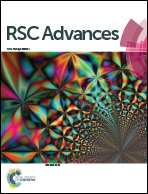Nitro-substituted 3,3′-bis(indolyl)methane-modified silica gel as a sorbent for solid-phase extraction of flavonoids†
Abstract
A novel solid-phase extraction (SPE) sorbent was synthesized by chemical immobilization of nitro-substituted 3,3′-bis(indolyl)methane onto pure silica. The nitro-substituted 3,3′-bis(indolyl)methane-modified silica was evaluated by elemental analysis (EA) and Fourier transform infrared spectroscopy (FT-IR). Coupled to high performance liquid chromatography (HPLC), the extraction performance of the sorbent was evaluated by using five flavonoids as model analytes. The results showed that the new sorbent could offer multiple intermolecular interactions, such as π–π, hydrophobic, and hydrogen bonding interactions. Several factors including the extraction material, sample solution pH, sample loading rate, eluent type, volume of eluent, elution rate, and volume of sample loading were optimized. Under the optimal conditions, the proposed method was applied for the analysis of five flavonoids in grape juice. Satisfactory linear ranges for flavonoids were obtained in the range of 10–200 ng mL−1 for myricetin, 5–200 ng mL−1 for quercetin and apigenin, and 1–200 ng mL−1 for luteolin and kaempferol, with correlation coefficients (R) ranging from 0.9908 to 0.9996. Limits of detection (LODs) were in the range of 0.5–10 ng mL−1. The recovery values of spiked grape juice ranged from 91.5% to 120.7% with relative standard deviations (RSDs) less than 9.12% (n = 5). As a novel solid-phase extraction sorbent, the nitro-substituted 3,3′-modified silica exhibited a higher extraction efficiency towards the tested compounds than diol-modified silica.


 Please wait while we load your content...
Please wait while we load your content...